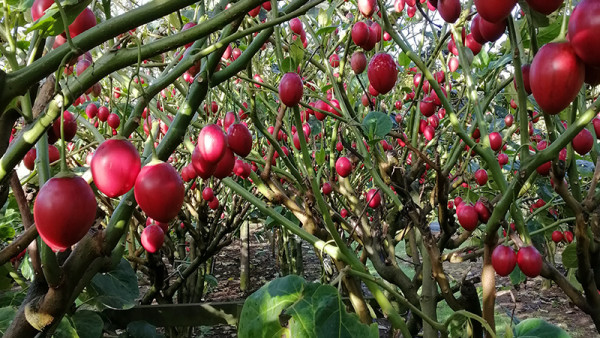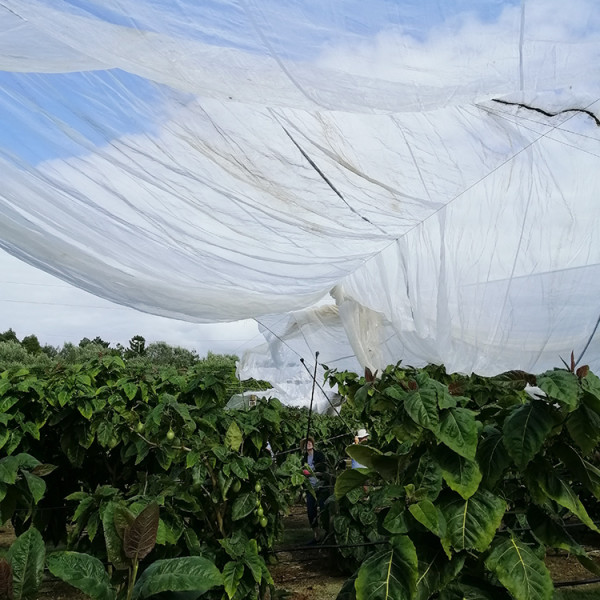TPP putting tamarillo growers under stress
6 April 2022
Written by Helena O'Neill
First published in the April 2022 issues of The Orchardist.

Tamarillo ripen at Robyn Wickenden and Aaron Davies’ orchard at Maungatapere, Northland.
Hot, dry summers and mild winters are putting extra pressure on the country’s tamarillo growers as Tomato Potato Psyllid (TPP) populations thrive. HELENA O’NEILL talks with Robyn Wickenden about how her Northland orchard is coping.
Robyn Wickenden and Aaron Davies bought a one-hectare tamarillo orchard just out of Maungatapere, Northland in late 2016. From there operating Mya Enterprises Ltd has been a steep learning curve in growing, picking, grading and selling tamarillos. Just two years later Robyn became secretary for the NZ Tamarillo Growers Association (NZTGA), and in March 2020 was made its chairperson.
And if battling a pandemic wasn’t hard enough, the Tomato Potato Psyllid (TPP) has been prolific leading to widespread Liberibacter infections on tamarillo orchards, particularly in Northland.
“Last year and the year before, we had two really dry, hot summers and mild winters. The psyllid absolutely blitzed everybody. This is one of the reasons we’ve gone down to such small grower numbers, people have decided to give up growing.”
Aaron and Robyn were one of just two tamarillo growers who exported the fruit last year.
“This year we won’t be exporting, we just won’t have the fruit.”
TPP was first detected around Pukekohe in tomatoes and potatoes in 2008, and the insect spread very rapidly to all growing areas during 2009 and 2010. TPP lives and reproduces on all plants from the Solanaceae family, including tomatoes, potatoes, capsicums, eggplant and such weeds as nightshade and tobacco weed.
“When the psyllid liberibacter infection came into New Zealand around 2008, it devastated our industry and we’re not big enough to keep fighting and doing the research and all the rest of it that needs to be done.”
Tomato crops have mostly shifted indoors as their way of combating it, while potato growers have found that putting their crops under netting made a big difference, Robyn says.
“I talked to Stephen Wratten who has since passed away, he was the one who was spearheading that research at Lincoln University. He said ‘why don’t you put your trees under psyllid netting?’ Our first thought was that it was not practical at all.”
The idea of trying to cover 3.5m high trees while keeping tractor access to the orchard was a daunting one.
“After the losses we’ve had over the past two years, we think this is the only solution. So, we built a structure to 4m high and we've had to glue netting together to make one big sheet that we could lift up over the orchard so that there was no point of entry for the psyllid.”
The orchard had 2200 trees of the Laird’s Large variety, but the couple had to remove about 200 trees in order to install supporting poles for the protective sheet.
The netting manufacturer was not able to stitch the netting together so the couple tested various means of attaching netting to itself to make that one sheet. They found the answer in a modified silicone glue, spending the better part of a week gluing sections of netting together.
"Trying to find contracting firms or someone to help us with the logistics has been impossible.”

Robyn and Aaron attempt to cover their tamarillo orchard with psyllid netting.
On 29 January the couple made their first attempt to hoist the net in place over the orchard.
“At 10 o’clock a 60kmh gust of wind came through and we then spent the next four hours battling holding the net in place. It was just like having the wind under a sail … by 2 o’clock we gave up and pulled it all back down again."
Since then, Robyn and her husband have been holding out for two calm days in order to get the netting in place over the orchard.
“We’ve had the windiest summer on record. It’s been a mission."
Finding a way to control TPP is crucial for the survival of Robyn and Aaron's orchard.
“The psyllid is absolutely devastating. It comes in and feeds off the tree, if there’s nothing to kill it then it just keeps on feeding and breeding. There’s not a lot around in the organic line that can keep it under control so we have to spray insecticides. The psyllid will still come in and bite the tree but the systemic spray stops them getting too far hopefully.”
With a withholding period before the picking season, the trees are left unprotected for a while, leaving them open to infestation.
“Because it’s been so warm the psyllid has kept on breeding. We don’t see them breeding on our orchard but there are host plants around — the native poroporo is one of the host plants up here in Northland, and then there are the boxthorn hedges in Taranaki which is their main host plant.”
In 2014 there were 60 active commercial tamarillo growers in the country, by last year this had dropped to about 25.
“I had another couple tell me that they were giving up this year, as they’ve got neighbours who grow organic and are putting pressure on them not to spray. The organic neighbours are growing things within the host family — they might have tamarillos or tomatoes or potatoes and they’re basically hosting the psyllids for the commercial grower next door.
“Some of those older growers, it’s been their passion for quite a while. They’ve just said they’re too old to be planting this number of trees all the time. It is hard labour pulling out an infected tree, then digging a hole and putting a tree in it.”
Meanwhile, other growers will be keeping an eye on Robyn and Aaron’s orchard to see if covering thousands of trees is the answer to protecting their tamarillo crops.
